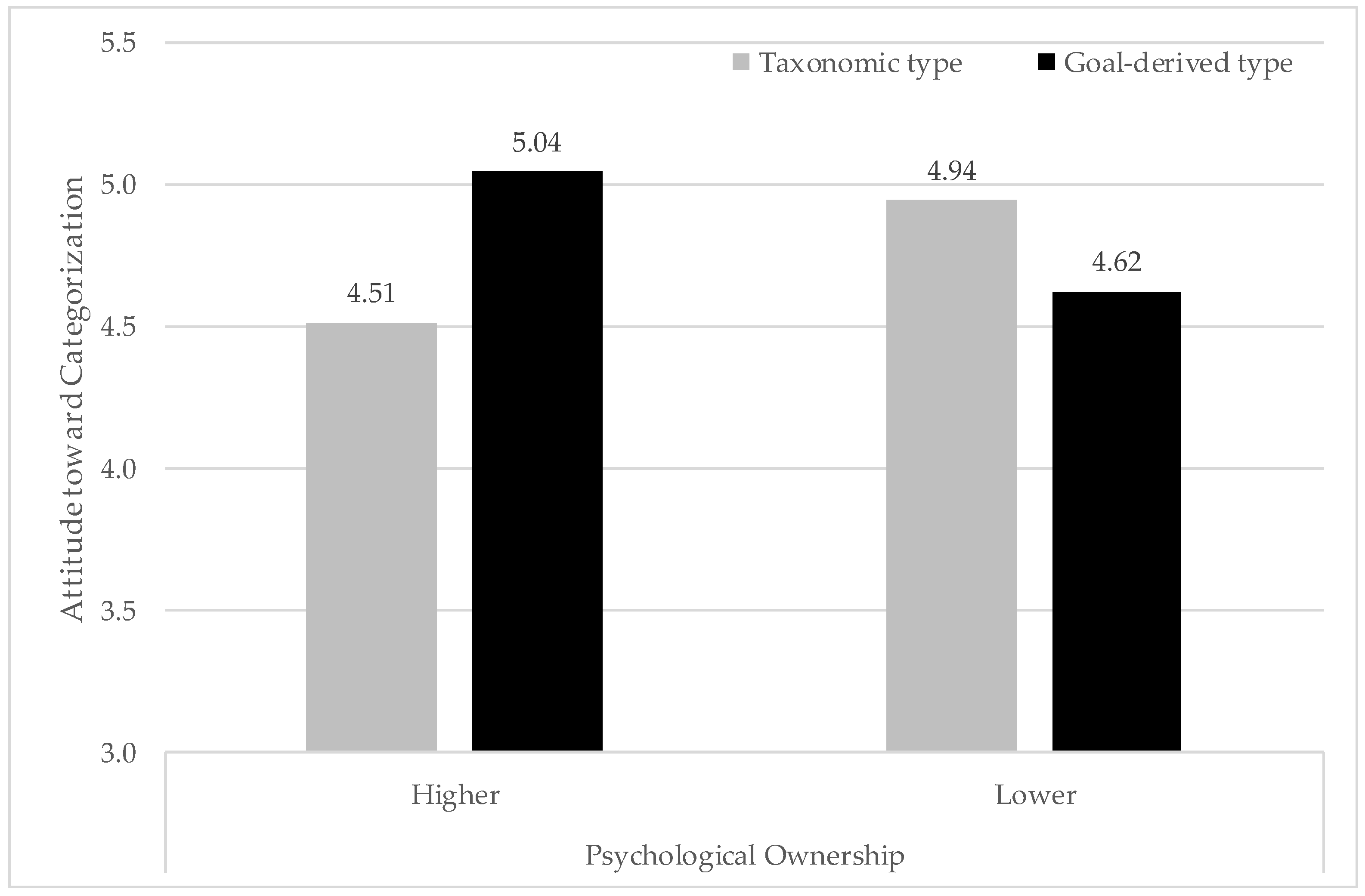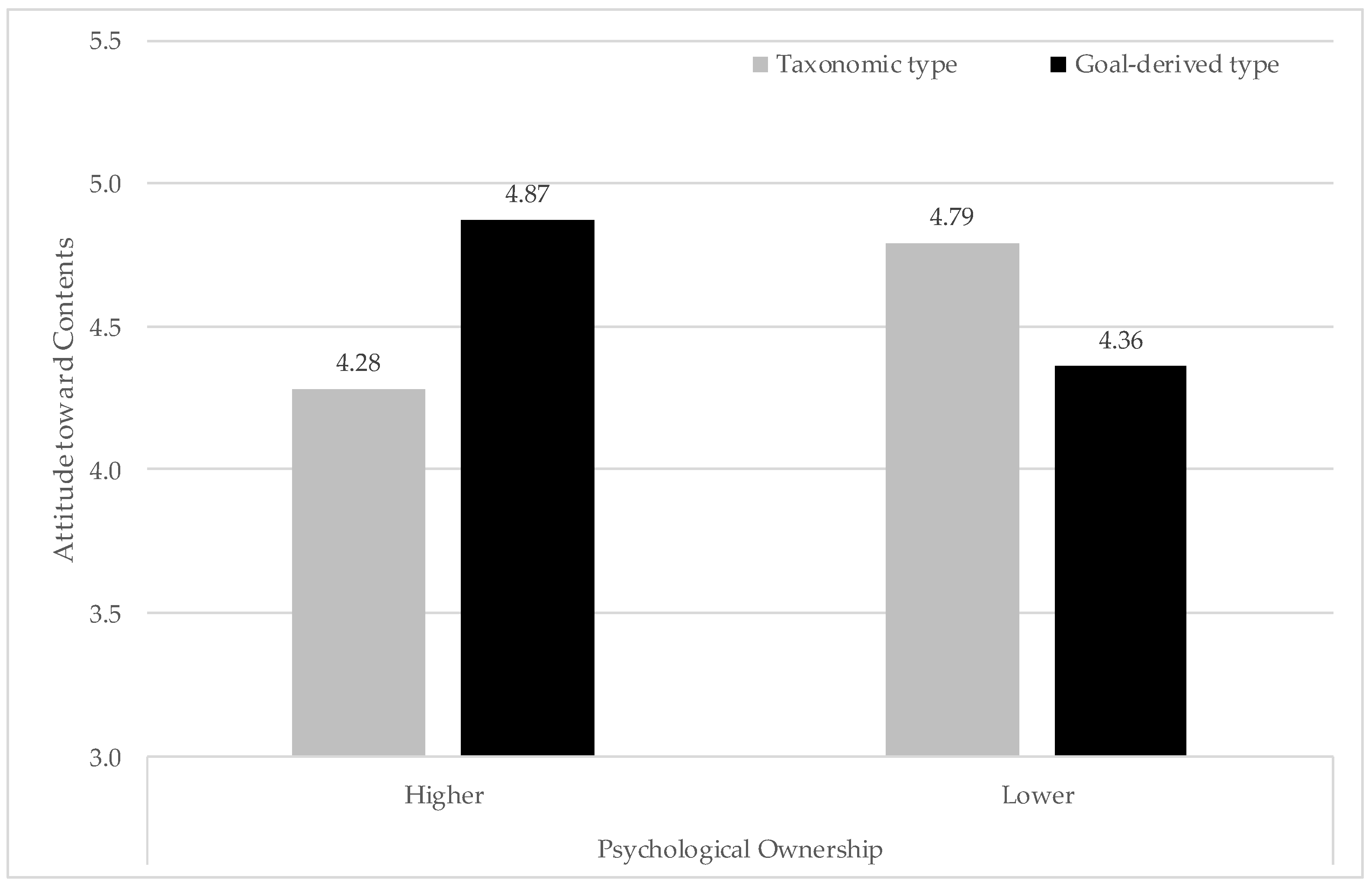The Effective Type of Information Categorization in Online Curation Service Depending on Psychological Ownership
Abstract
:1. Introduction
2. Literature Review
2.1. Categorization Theory
2.2. Psychological Ownership
2.3. The Role of Psychological Ownership in the Online Curation Service
3. Research Method
3.1. Design and Participants
3.2. Procedure and Measurements
4. Research Results
4.1. Manipulation Check
4.2. Hypotheses Test
4.3. Additional Analysis
5. Conclusions
Author Contributions
Funding
Acknowledgments
Conflicts of Interest
References
- Barsalou, L.W. Deriving categories to achieve goals. In Psychology of Learning and Motivation; Elsevier: Amsterdam, The Netherlands, 1991. [Google Scholar]
- Felcher, E.M.; Malaviya, P.; McGill, A.L. The role of taxonomic and goal-derived product categorization in, within, and across category judgments. Psychol. Mark. 2001, 18, 865–887. [Google Scholar] [CrossRef]
- Barsalou, L.W. Ideals, central tendency, and frequency of instantiation as determinants of graded structure in categories. J. Exp. Psychol. Learn. Mem. Cogn. 1985, 11, 629. [Google Scholar] [CrossRef] [PubMed]
- Barsalou, L.W. Ad hoc categories. Mem. Cogn. 1983, 11, 211–227. [Google Scholar] [CrossRef] [PubMed] [Green Version]
- Pierce, J.L.; Kostova, T.; Dirks, K.T. The state of psychological ownership: Integrating and extending a century of research. Rev. Gen. Psychol. 2003, 7, 84–107. [Google Scholar] [CrossRef]
- Pierce, J.L.; Kostova, T.; Dirks, K.T. Toward a theory of psychological ownership in organizations. Acad. Manag. Rev. 2001, 26, 298–310. [Google Scholar] [CrossRef] [Green Version]
- Chrysikou, E.G. When shoes become hammers: Goal-derived categorization training enhances problem-solving performance. J. Exp. Psychol. Learn. Mem. Cogn. 2006, 32, 935. [Google Scholar] [CrossRef] [Green Version]
- Loken, B.; Barsalou, L.W.; Joiner, C. Categorization theory and research in consumer psychology. In Handbook of Consumer Psychology; Haugtvedt, C.P., Herr, P., Kardes, F., Eds.; Taylor & Francis: Oxfordshire, UK, 2018; pp. 133–165. [Google Scholar]
- Smith, E.E.; Medin, D.L. Categories and Concepts; Harvard University Press: Cambridge, MA, USA, 1981. [Google Scholar]
- Mervis, C.B.; Rosch, E. Categorization of natural objects. Annu. Rev. Psychol. 1981, 32, 89–115. [Google Scholar] [CrossRef]
- Van Mechelen, I.; Hampton, J.; Michalski, R.S.; Theuns, P. Categories and concepts. Cogn. Sci. Ser. 1993. [Google Scholar]
- Ratneshwar, S.; Barsalou, L.W.; Pechmann, C.; Moore, M. Goal-derived categories: The role of personal and situational goals in category representations. J. Consum. Psychol. 2001, 10, 147–157. [Google Scholar] [CrossRef]
- Martin, I.M.; Stewart, D.W. The differential impact of goal congruency on attitudes, intentions, and the transfer of brand equity. J. Mark. Res. 2001, 38, 471–484. [Google Scholar] [CrossRef]
- Park, C.W.; Milberg, S.; Lawson, R. Evaluation of brand extensions: The role of product feature similarity and brand concept consistency. J. Consum. Res. 1991, 18, 185–193. [Google Scholar] [CrossRef]
- Meyers-Levy, J.; Tybout, A.M. Schema congruity as a basis for product evaluation. J. Consum. Res. 1989, 16, 39–54. [Google Scholar] [CrossRef]
- Medin, D.L.; Smith, E.E. Strategies and classification learning. J. Exp. Psychol. Hum. Learn. Mem. 1981, 7, 241. [Google Scholar] [CrossRef]
- Medin, D.L.; Schaffer, M.M. Context theory of classification learning. Psychol. Rev. 1978, 85, 207. [Google Scholar] [CrossRef]
- Barsalou, L.W. Context-independent and context-dependent information in concepts. Mem. Cogn. 1982, 10, 82–93. [Google Scholar] [CrossRef]
- Moreau, C.P.; Markman, A.B.; Lehmann, D.R. “What is it?” Categorization flexibility and consumers’ responses to really new products. J. Consum. Res. 2001, 27, 489–498. [Google Scholar] [CrossRef]
- Sujan, M.; Dekleva, C. Product categorization and inference making: Some implications for comparative advertising. J. Consum. Res. 1987, 14, 372–378. [Google Scholar] [CrossRef]
- Van Dyne, L.; Pierce, J.L. Psychological ownership and feelings of possession: Three field studies predicting employee attitudes and organizational citizenship behavior. J. Organ. Behav. Int. J. Ind. Occup. Organ. Psychol. Behav. 2004, 25, 439–459. [Google Scholar] [CrossRef]
- Furby, L. Possession in humans: An exploratory study of its meaning and motivation. Soc. Behav. Pers. Int. J. 1978, 6, 49–65. [Google Scholar] [CrossRef]
- Atasoy, O.; Morewedge, C.K. Digital goods are valued less than physical goods. J. Consum. Res. 2018, 44, 1343–1357. [Google Scholar] [CrossRef] [Green Version]
- Asatryan, V.S.; Oh, H. Psychological ownership theory: An exploratory application in the restaurant industry. J. Hosp. Tour. Res. 2008, 32, 363–386. [Google Scholar] [CrossRef]
- Jussila, I.; Tarkiainen, A.; Sarstedt, M.; Hair, J.F. Individual psychological ownership: Concepts, evidence, and implications for research in marketing. J. Mark. Theory Pract. 2015, 23, 121–139. [Google Scholar]
- Zhao, Q.; Chen, C.-D.; Wang, J.-L. The effects of psychological ownership and TAM on social media loyalty: An integrated model. Telemat. Inform. 2016, 33, 959–972. [Google Scholar] [CrossRef]
- Lee, H.; Yang, S.-B.; Koo, C. Exploring the effect of Airbnb hosts’ attachment and psychological ownership in the sharing economy. Tour. Manag. 2019, 70, 284–294. [Google Scholar] [CrossRef]
- Stoner, J.L.; Loken, B.; Stadler Blank, A. The name game: How naming products increases psychological ownership and subsequent consumer evaluations. J. Consum. Psychol. 2018, 28, 130–137. [Google Scholar] [CrossRef]
- Seo, B.-G.; Park, D.-H. Did You Invest Less Than Me? The Effect of Other’s Share of Investment on Psychological Ownership of Crowdfunding Projects. Sustainability 2020, 12, 2025. [Google Scholar] [CrossRef] [Green Version]
- Paundra, J.; Rook, L.; Van Dalen, J.; Ketter, W. Preferences for car sharing services: Effects of instrumental attributes and psychological ownership. J. Environ. Psychol. 2017, 53, 121–130. [Google Scholar] [CrossRef] [Green Version]
- Kirk, C.P. Dogs have masters, cats have staff: Consumers’ psychological ownership and their economic valuation of pets. J. Bus. Res. 2019, 99, 306–318. [Google Scholar] [CrossRef]
- Shu, S.B.; Peck, J. Psychological ownership and affective reaction: Emotional attachment process variables and the endowment effect. J. Consum. Psychol. 2011, 21, 439–452. [Google Scholar] [CrossRef]
- Buchko, A.A. Effects of employee ownership on employee attitudes: A test of three theoretical perspectives. Work Occup. 1992, 19, 59–78. [Google Scholar] [CrossRef]
- Pierce, J.L.; Rubenfeld, S.A.; Morgan, S. Employee ownership: A conceptual model of process and effects. Acad. Manag. Rev. 1991, 16, 121–144. [Google Scholar] [CrossRef]
- Lee, J.; Suh, A. How do virtual community members develop psychological ownership and what are the effects of psychological ownership in virtual communities? Comput. Hum. Behav. 2015, 45, 382–391. [Google Scholar] [CrossRef]
- Seo, B.-G.; Park, D.-H. The effect of message framing on security behavior in online services: Focusing on the shift of time orientation via psychological ownership. Comput. Hum. Behav. 2019, 93, 357–369. [Google Scholar] [CrossRef]
- Danckwerts, S.; Kenning, P. “It’s MY Service, it’s MY Music”: The role of psychological ownership in music streaming consumption. Psychol. Mark. 2019, 36, 803–816. [Google Scholar] [CrossRef]
- Villi, M.; Moisander, J.; Joy, A. Social Curation in Consumer Communities: Consumers As Curators of Online Media Content. Adv. Consum. Res. 2012, 40, 490–495. [Google Scholar]
- Choi, N.H.; Na, K.J. The Influences of Consumers’ Prior Knowledge on Product Typicality and Preference Evaluation. Korean J. Mark. 2000, 15, 23–44. [Google Scholar]
- Peck, J.; Shu, S.B. The effect of mere touch on perceived ownership. J. Consum. Res. 2009, 36, 434–447. [Google Scholar] [CrossRef]
- Martin, I.M.; Stewart, D.W.; Matta, S. Branding strategies, marketing communication, and perceived brand meaning: The transfer of purposive, goal–oriented brand meaning to brand extensions. J. Acad. Mark. Sci. 2005, 33, 275–294. [Google Scholar] [CrossRef]
- Ajzen, I.; Fishbein, M. Attitude-behavior relations: A theoretical analysis and review of empirical research. Psychol. Bull. 1977, 84, 888. [Google Scholar] [CrossRef]
- Sinclair, G.; Tinson, J. Psychological ownership and music streaming consumption. J. Bus. Res. 2017, 71, 1–9. [Google Scholar] [CrossRef]
- Kirk, C.P.; Peck, J.; Swain, S.D. Property lines in the mind: Consumers’ psychological ownership and their territorial responses. J. Consum. Res. 2018, 45, 148–168. [Google Scholar] [CrossRef]
- Karahanna, E.; Xu, S.X.; Zhang, N. Psychological ownership motivation and use of social media. J. Mark. Theory Pract. 2015, 23, 185–207. [Google Scholar]
- Peck, J.; Barger, V.A.; Webb, A. In search of a surrogate for touch: The effect of haptic imagery on perceived ownership. J. Consum. Psychol. 2013, 23, 189–196. [Google Scholar] [CrossRef]
- Lessard-Bonaventure, S.; Chebat, J.-C. Psychological ownership, touch, and willingness to pay for an extended warranty. J. Mark. Theory Pract. 2015, 23, 224–234. [Google Scholar]
- Dhar, R.; Wertenbroch, K. Consumer choice between hedonic and utilitarian goods. J. Mark. Res. 2000, 37, 60–71. [Google Scholar] [CrossRef]
- Lee, S.J.; Seo, B.-G.; Park, D.-H. Development of Music Recommendation System based on Customer Sentiment Analysis. J. Intell. Inf. Syst. 2018, 24, 197–217. [Google Scholar]
- Seo, B.-G.; Kim, K.-W.; Park, D.-H. Development of Beauty Experience Pattern Map Based on Consumer Emotions: Focusing on Cosmetics. J. Intell. Inf. Syst. 2019, 25, 179–196. [Google Scholar]
- Yoo, I.-J.; Seo, B.-G.; Park, D.-H. Smart store in Smart City: The development of smart trade area analysis system based on consumer sentiments. J. Intell. Inf. Syst. 2018, 24, 25–52. [Google Scholar]




| Category Types | Psychological Ownership | Mean | Std. Deviation | N |
|---|---|---|---|---|
| Taxonomic | Higher | 4.51 | 0.94 | 58 |
| Lower | 4.94 | 0.90 | 60 | |
| Goal-derived | Higher | 5.04 | 0.81 | 61 |
| Lower | 4.62 | 0.82 | 55 |
| Source | Sum of Squares | Degree of Freedom | Mean Square | F-Value | p-Value |
|---|---|---|---|---|---|
| Corrected Model | 14.216 | 5 | 2.843 | 3.780 | 0.003 |
| Intercept | 149.853 | 1 | 149.853 | 199.207 | 0.000 |
| Gender | 0.201 | 1 | 0.201 | 0.267 | 0.606 |
| Age | 2.115 | 1 | 2.115 | 2.812 | 0.095 |
| Category Types (Taxonomic vs. Goal-derived) | 0.002 | 1 | 0.002 | 0.003 | 0.957 |
| Psychological Ownership (Higher vs. Lower) | 0.834 | 1 | 0.834 | 1.109 | 0.293 |
| Category Types × Psychological Ownership | 11.009 | 1 | 11.009 | 14.635 | 0.000 |
| Error | 171.513 | 228 | 0.752 |
| Category Types | Psychological Ownership | Mean | Std. Deviation | N |
|---|---|---|---|---|
| Taxonomic | Higher | 4.28 | 1.00 | 58 |
| Lower | 4.79 | 0.93 | 60 | |
| Goal-derived | Higher | 4.87 | 0.86 | 61 |
| Lower | 4.36 | 0.73 | 55 |
| Source | Sum of Squares | Degree of Freedom | Mean Square | F-Value | p-Value |
|---|---|---|---|---|---|
| Corrected Model | 17.925 | 5 | 3.585 | 4.489 | 0.001 |
| Intercept | 145.293 | 1 | 145.293 | 181.926 | 0.000 |
| Gender | 0.091 | 1 | 0.091 | 0.114 | 0.736 |
| Age | 1.928 | 1 | 1.928 | 2.414 | 0.122 |
| Category Types (Taxonomic vs. Goal-derived) | 0.001 | 1 | 0.001 | 0.001 | 0.979 |
| Psychological Ownership (Higher vs. Lower) | 0.545 | 1 | 0.545 | 0.682 | 0.410 |
| Category Types × Psychological Ownership | 15.658 | 1 | 15.658 | 19.605 | 0.000 |
| Error | 182.089 | 228 | 0.799 |
© 2020 by the authors. Licensee MDPI, Basel, Switzerland. This article is an open access article distributed under the terms and conditions of the Creative Commons Attribution (CC BY) license (http://creativecommons.org/licenses/by/4.0/).
Share and Cite
Seo, B.-G.; Park, D.-H. The Effective Type of Information Categorization in Online Curation Service Depending on Psychological Ownership. Sustainability 2020, 12, 3321. https://doi.org/10.3390/su12083321
Seo B-G, Park D-H. The Effective Type of Information Categorization in Online Curation Service Depending on Psychological Ownership. Sustainability. 2020; 12(8):3321. https://doi.org/10.3390/su12083321
Chicago/Turabian StyleSeo, Bong-Goon, and Do-Hyung Park. 2020. "The Effective Type of Information Categorization in Online Curation Service Depending on Psychological Ownership" Sustainability 12, no. 8: 3321. https://doi.org/10.3390/su12083321





